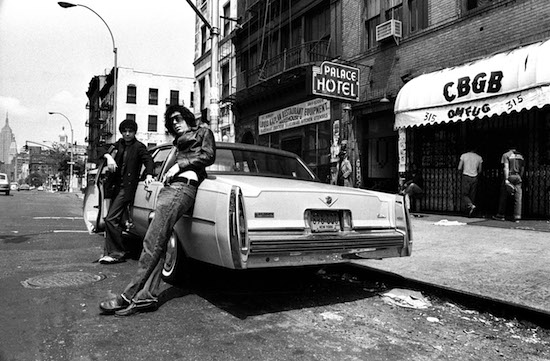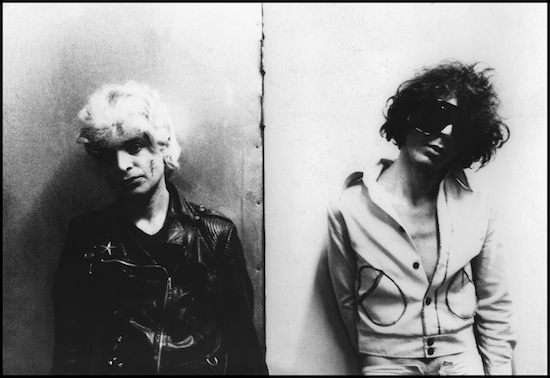Suicide portraits by Curtis Knapp
Early in 1977, Suicide, along with manager Marty Thau, producer Craig Leon and engineer Larry Alexander, finally went to record their debut album at Ultima Studios, in Upper New York. It was a small, slightly dingy building with one recording room and a compact control room containing a custom built console. Earlier that decade while the space was still known as 914 Sound Studios, future Suicide fan, Bruce Springsteen recorded tracks there for Greetings From Asbury Park, N.J., The Wild, The Innocent & The E Street Shuffle and Born To Run.
Craig Leon says: “I think it used to be a bowling alley. It was very typical of the day and had very little in the way of effects. It was totally analog of course, with a couple of delays. The console was extremely microphonic; the equalisation was tuned in octaves of A and you could really overdrive sends if you wanted and this actually helped [Suicide’s] sound. It didn’t have much separation but there was “a booth” [fashioned from baffles] set up for Alan with Martin set up in the main room.”
This “set up” was very basic. Martin had his Seeburg Rhythm Prince drum machine and a Farfisa keyboard run through two Electro Harmonix distortion pedals in a chain with a small transistor radio (used to devastating effect on ‘Frankie Teardrop Detective’) all running into a Fender top and then straight into one channel on the desk. There was another send straight from the Rhythm Prince bypassing the effects and into a second channel and there was a third channel for vocals. All other production was either done live via the desk (by printing effects directly across into other channels) or later in the mix.
Martin confirms how simple the actual recording was: “There was no conversation saying, ‘Oh ‘Rocket U.S.A.’ should be the first track on the album.’ We just recorded our set live in the studio, exactly as we had been playing it for years, all in the order that you hear it on the album. It took us the amount of time it takes you to listen to the album for us to record it. About 35 minutes.”
Their set, played in order, was ‘Ghost Rider’, ‘Rocket U.S.A.’, the tender-hearted ‘Cheree’, the 21st Century rockabilly pulse of ‘Johnny’ and the torrid, nightmarish R&B of ‘Girl’ which were destined for side one. And then the monumental ‘Frankie Teardrop Detective’ and the sepulchral lament to the death of 60s idealism, ‘Che’, both bound for side two.
Larry Alexander was the in-house engineer who had previously cut his own album: an all-synthesizer version of Tchaikovsky’s ‘1812 Overture’ and ‘The Nutcracker Suite’, but it’s unclear what effect – if any – he had on the process. Martin remembers him as being a “great guy” but says that he was taken aback by some of the extreme audio experiments that Marty Thau was instigating. Craig Leon is dismissive about his involvement saying: “I think he had minimal input… he was very hands off… I don’t even think he had any love for the project.”
The really breath-taking vocal effects were created live on the desk by Craig Leon, assisted by Thau, who used the studio’s tape-delay slapback and an Eventide digital delay unit instead of the standard practice of using a Roland Space Echo, sending all of the effects back to be “printed” on other free channels. These were essentially hardcore dub techniques he learned on his previous job working in Jamaica with Lee ‘Scratch’ Perry and Bob Marley. The band were unaware of the Caribbean connection but oddly enough, says Craig Leon, both Suicide and Scratch may have shared a similar root inspiration for the use of delay on the vocals: Sun Records, the original home of Elvis Presley. He explains: “It was actually the same kind of set-up [at Sun as it was at The Black Ark] except the dub method fed back on itself more.”

Suicide outside CBGB by Adrian Boot
If the session initially started off like a dream, things soon began to fray however. Craig had a previous production engagement to fulfil in LA and left the other four with rough monitor mixes. This meant that in theory “all” they could do was adjust the volume of the three main channels and adjust the effects channels but things didn’t run so smoothly.
Thau – who had no production experience – decided to take the reins from Craig after he left for LA. Rev says: “Marty said to us, ‘I think I’ll produce the album. What do you think?’ And we just said, ‘Go ahead, do it.’ I think it took Larry aback at times seeing us pushing everything way beyond what you’re supposed to do.”
Getting inspiration from a huge bag of grass, the trio pushed the effects on all of the tracks to the limit, hoping to draw more of the overwhelmingly intense Suicide live experience out of the recordings. But also in this period, one other significant change was made. After reading a distressing news story, about a factory worker who killed his family and then himself, Alan recorded a new vocal to ‘Frankie Teardrop’ (and dropped the ‘Detective’ reference in the process) making it arguably the most harrowing and intense ten and a half minutes of audio ever committed to tape, replete with screams and exhortations that still have the power to chill the listener to the marrow.
Another person who was shocked to the core when he heard the record was Marv Schlachter, the owner of Prelude, the parent company to Red Star… but not in a good way. Prelude was a disco label and dance-floor orientated sounds, especially the newer electronic beats of Giorgio Moroder, were the order of the day. The first mix of the album was so blown out that apparently the rhythm machine could no longer be heard under the sonic avalanche. (If you listen carefully to ‘Frankie Teardrop’ now, you will notice that when Alan’s screams crescendo, the beat still disappears rapidly into the mix.)
Craig Leon arrived back in New York to work on the mix with Marty Thau. Which final mixes actually made it onto the album is a contentious point but according to Martin Rev: “I would say ‘Rocket U.S.A.’ definitely and ‘Ghost Rider’, ‘Frankie Teardrop’ and ‘Cheree’ were probably from Marty Thau’s mix and everything else was Craig’s.” Craig Leon remembers things slightly differently saying: “Of Marty’s mixes ‘Cheree’ and one or maybe two other tracks made the final cut”, before adding diplomatically: “[The final adjustments to the mix that Marty and I made together] weren’t really that radical though.”
And after mastering the album with renowned Atlantic Records engineer George Piros – known in the business as the “human groove optimization computer” – at Frankford/Wayne, NYC, they were ready to present their vision to the world.
The Art Of The Album reissue of Suicide is out now on Mute/BMG
Walthamstow Rock ‘N’ Roll Book Club are holding a full album playback and panel discussion with Kris Needs, Jay Burnett and John Doran, tomorrow night, Tuesday 16 July


